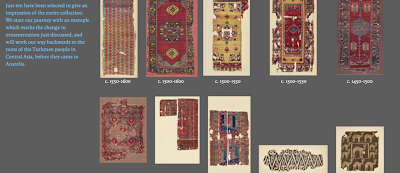I've been picking and choosing textile presentations this week, and here's what I think is the best of the current offerings. Blessedly the sound quality was good and the presenter experienced.
The terminology was pretty specialized, but I did my humble best. Here's what the Haaji Baba Rug Club just put up online.
Michael Franzes, a dry, erudite old Brit, took us through the highly selective Orient Stars collection of Anatolian wool rugs from 400 BCE to about 1000 CE. They've established these ages by carbon dating.
One interesting point: some rugs with very similar motifs and general design have been dated as much as 300 years apart. Before carbon dating I wonder if they'd have been thought to be similar in age.
There were animal and bird motifs, my favorite being this chicken
And bactrian camels. Notice the wool riding boots, with chicken motifs. I'll bet the boots were felted for weatherproofing and long wear
This map shows the passage of rugs trading back and forward over the region of the Silk Road. It's been a commercial highway for many centuries.
There was some discussion of the significance of the symbols and he tactfully said it continues to be a matter of conjecture. Rather than saying I dunno really, don't ask me, I only work here.
It's interesting, once you've seen these rugs, to see them depicted in Renaissance paintings, in the homes of wealthy patrons of the arts.
Another art related point I liked was the motif of an animal head crossing into the space of a border, seen in rugs also in ancient mosaics. See this next image. This is a trusty design feature, which I like to use to this day, to break the distance between viewer and design.
And I really love this design and plan to swipe it at some point.









Fascinating. Whoever created that last design, that person must have been very skilled or else I need to know more about knotting. The elements are like each other. Nice design.
ReplyDeleteKnotting is the process of tyying each tiny piece of yarn to the base support of the rug. Many stitches to the inch in fine silk rugs. Fewer in the wool ones like here. I'm guessing the design was drawn on the backing.
ReplyDeleteVery intricate and beautiful.
ReplyDeletewe rely so much on modern technology that we marvel that people did such beautiful sophisticated work with 'primitive' tools.
ReplyDeleteExactly. It's one reason for hand sewing, spindle spinning, collecting plants for dyeing, processing wool by hand, you get an insight into the sheer skills involved in these works. If you look on YouTube to see hand knotting happening, you can't believe the speed and accuracy of the worker's hands. Even slowed down, it's fast!
DeleteEllen's comment re modern technology vs. what we term as primitive tools made me think of woodworking as well. Much of what we now look upon as being incredibly detailed (wood or fibre) cannot even begin to be duplicated with today's so-called advanced technology.
ReplyDelete